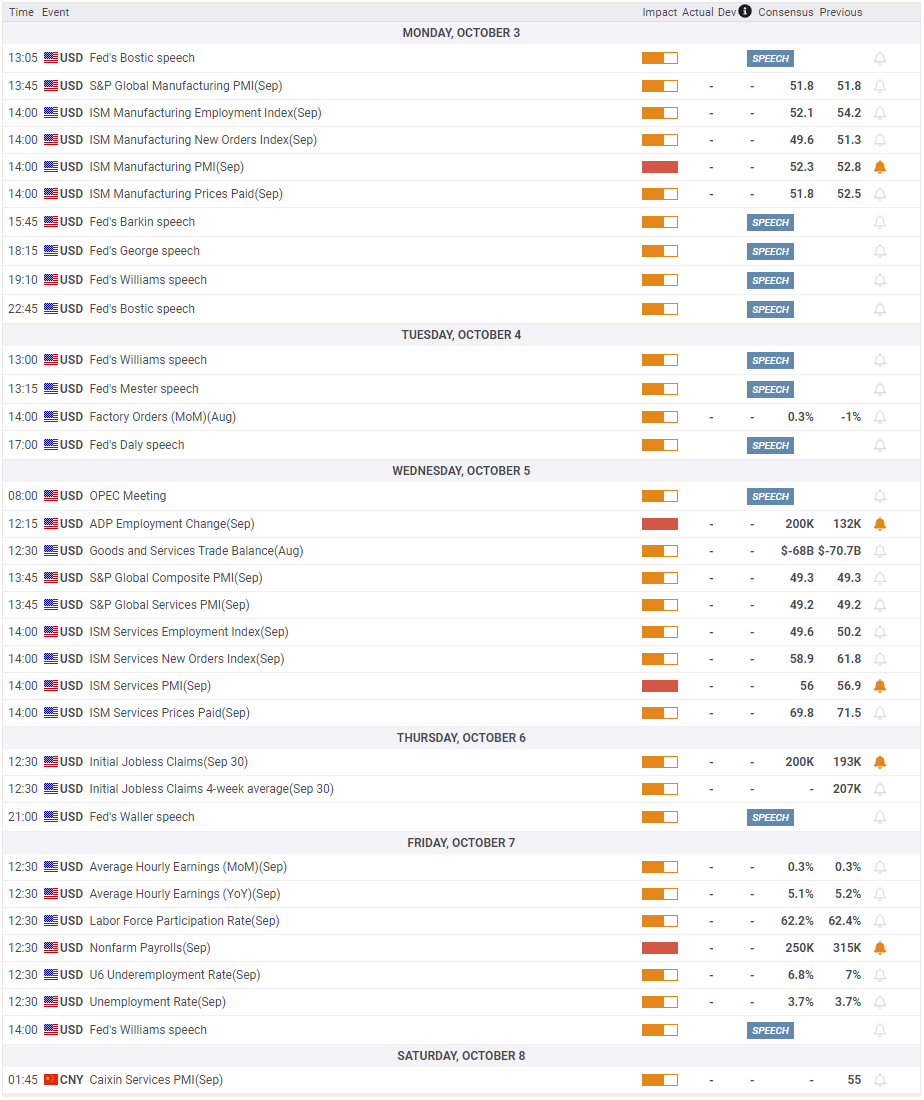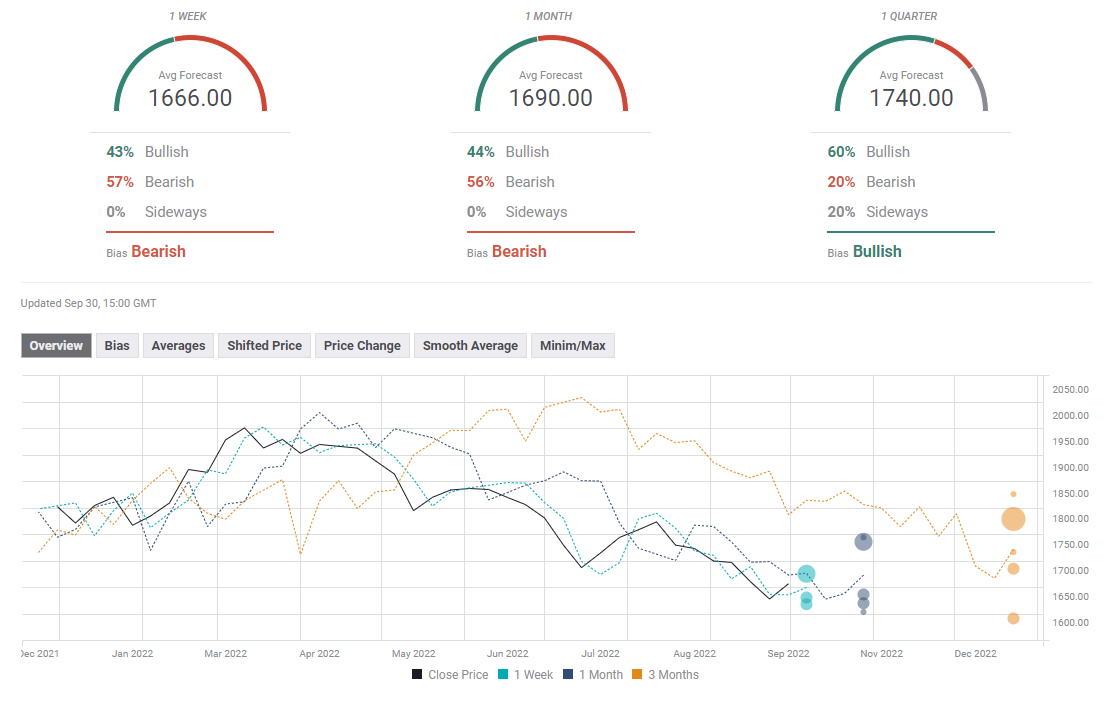- Gold capitalized on the pullback witnessed in global bond yields.
- XAU/USD could gather bullish momentum if it manages to clear $1,680.
- ISM PMI surveys and September jobs report will be featured in the US economic docket.
Gold started the week under selling pressure and declined toward $1,620 on Monday before staging a rebound and closing four straight days in positive territory. XAU/USD ended up snapping a two-week losing streak ahead of next week's ISM PMI surveys and the September jobs report.
What happened last week?
The turmoil in global bond markets caused by the UK gilt sell-off at the beginning of the week weighed on the low-yielding gold. With the benchmark 10-year US Treasury bond yield rising toward 4% on Monday, XAU/USD turned south and registered its lowest daily close since March 2020 at $1,622.
The yellow metal shook off the bearish pressure on Tuesday and closed the day modestly higher. The monthly data published by the Conference Board showed that the Consumer Confidence Index in the US improved to 108.00 in September from 103.6 in August. Although the dollar gathered some strength with the initial reaction, the underlying details of the publication revealed that the 1-year Consumer Inflation Rate Expectations declined to 6.8% from 7%, limiting the USD’s upside.
On Wednesday, the Bank of England (BoE) intervened in the gilt market and triggered a sharp decline in global bond yields. The UK central bank announced that it will carry out temporary purchases of long-dated government bonds to restore market functioning. Led by a 10% decline in the 10-year UK gilt yield, the 10-year US T-bond yield lost more than 5% and allowed inversely-correlated gold to gather bullish momentum. XAU/USD rose nearly 2% and posted its largest one-day gain since late March.
The BoE’s action pulled markets’ interest away from the greenback and paved the way for an overdue correction in the US Dollar Index (DXY). With the dollar facing strong bearish pressure, the DXY fell more than 2% in the second half of the week. During the Asian trading hours on Friday, the data from China showed that the NBS Manufacturing PMI rose into the expansionary territory above 50 in September from 49.4 in August and helped gold advance to its highest level in a week above $1,670 on Friday.
Meanwhile, the US Bureau of Economic Analysis (BEA) reported on Thursday that the real Gross Domestic Product (GDP) contracted at an annualized rate of 0.6% in the second quarter. This reading matched the previous estimate and the market expectation, failing to generate a noticeable market reaction. The BEA announced on Friday that the Personal Consumption Expenditures Price Index declined to 6.2% on a yearly basis in August from 6.4% in July. The core PCE inflation, however, rose to 4.9% in the same period making it difficult for gold to preserve its bullish momentum.
It’s also worth noting that the People’s Bank of China (PBoC) introduced measures to limit the CNY’s depreciation this week. The PBoC reinstated the reserve requirement rule for banks’ forward sales of CNY by raising the required ratio to 20% from 0%. In case this action has the intended impact on the CNY’s exchange rate, the Chinese demand for gold could improve and support the price.
Next week
Market participants will keep a close eye on global bond markets next week. The UK gilt market seems to have stabilized following the BoE’s intervention but investors could quickly lose confidence in case the UK government fails to address concerns over the economy getting pushed toward an unsustainable debt path. Another bout of the global bond sell-off could weigh on the precious metal. On the other hand, if the UK provides further relief to gilt markets by readjusting the fiscal policy, another leg lower in bond yields should help gold stretch higher.
The US economic docket will feature the ISM Manufacturing PMI data, which is expected to remain unchanged at 52.8 in September, on Monday. The inflation component of the survey, the Price Paid Index, fell to 52.5 in August and a reading below 50 in September would point to falling input prices for the manufacturing sector and lift XAU/USD. On Wednesday, the ISM will release the Services PMI report. Price pressures were relatively strong in the service sector in August with the Prices Paid Index arriving at 71.5. A significant deceleration in the service sector inflation is likely to hurt the dollar and vice versa.
On Friday, the US Bureau of Economic Analysis will publish the September jobs report. Nonfarm Payrolls are expected to rise by 250,000 following August’s increase of 315,000. Weekly Initial Jobless Claims have been steadily declining since mid-Summer but employment components of August PMI surveys showed a significant slowdown in employment growth in the private sector.
According to the latest Summary of Projections (SEP), Fed officials see an Unemployment Rate of 3.8% by year-end and 4.4% by the end of 2023. Policymakers made it clear that they will prioritize battling inflation and continue to hike rates until they see signs of unemployment rising steadily. Hence, labor market figures for September are unlikely to impact the Fed’s policy outlook in a significant way. Nevertheless, investors could see a weaker-than-forecast NFP growth as an excuse to sell the dollar and open the door for bullish action in XAU/USD ahead of the weekend. On the flip side, market participants could look to add to their dollar longs if the NFP increases at a stronger pace than projected.
Gold technical outlook
Gold faces immediate resistance at $1,680, where the 20-day SMA is located. In case the yellow metal rises above that level and starts using it as support, it could target $1,690 (Fibonacci 38.2% retracement of the latest downtrend) and $1,700 (psychological level). Ideally, the Relative Strength Index (RSI) indicator on the daily chart would hold above 50 in that scenario and confirm the bullish shift in the technical outlook.
On the downside, $1,665 (Fibonacci 23.6% retracement) aligns as first support before $1,650 (static level). A daily close below the latter could be seen as a significant bearish development and cause XAU/USD to decline toward the end-point of the downtrend at $1,620.
Gold sentiment poll
The FXStreet forecast poll paints a mixed picture for gold in the one-week and one-month outlooks. Average targets for these time periods are located at $1,666 and $1,690, respectively.
Information on these pages contains forward-looking statements that involve risks and uncertainties. Markets and instruments profiled on this page are for informational purposes only and should not in any way come across as a recommendation to buy or sell in these assets. You should do your own thorough research before making any investment decisions. FXStreet does not in any way guarantee that this information is free from mistakes, errors, or material misstatements. It also does not guarantee that this information is of a timely nature. Investing in Open Markets involves a great deal of risk, including the loss of all or a portion of your investment, as well as emotional distress. All risks, losses and costs associated with investing, including total loss of principal, are your responsibility. The views and opinions expressed in this article are those of the authors and do not necessarily reflect the official policy or position of FXStreet nor its advertisers. The author will not be held responsible for information that is found at the end of links posted on this page.
If not otherwise explicitly mentioned in the body of the article, at the time of writing, the author has no position in any stock mentioned in this article and no business relationship with any company mentioned. The author has not received compensation for writing this article, other than from FXStreet.
FXStreet and the author do not provide personalized recommendations. The author makes no representations as to the accuracy, completeness, or suitability of this information. FXStreet and the author will not be liable for any errors, omissions or any losses, injuries or damages arising from this information and its display or use. Errors and omissions excepted.
The author and FXStreet are not registered investment advisors and nothing in this article is intended to be investment advice.
Recommended Content
Editors’ Picks
AUD/USD remained bid above 0.6500

AUD/USD extended further its bullish performance, advancing for the fourth session in a row on Thursday, although a sustainable breakout of the key 200-day SMA at 0.6526 still remain elusive.
EUR/USD faces a minor resistance near at 1.0750

EUR/USD quickly left behind Wednesday’s small downtick and resumed its uptrend north of 1.0700 the figure, always on the back of the persistent sell-off in the US Dollar ahead of key PCE data on Friday.
Gold holds around $2,330 after dismal US data

Gold fell below $2,320 in the early American session as US yields shot higher after the data showed a significant increase in the US GDP price deflator in Q1. With safe-haven flows dominating the markets, however, XAU/USD reversed its direction and rose above $2,340.
Bitcoin price continues to get rejected from $65K resistance as SEC delays decision on spot BTC ETF options

Bitcoin (BTC) price has markets in disarray, provoking a broader market crash as it slumped to the $62,000 range on Thursday. Meanwhile, reverberations from spot BTC exchange-traded funds (ETFs) continue to influence the market.
US economy: slower growth with stronger inflation

The dollar strengthened, and stocks fell after statistical data from the US. The focus was on the preliminary estimate of GDP for the first quarter. Annualised quarterly growth came in at just 1.6%, down from the 2.5% and 3.4% previously forecast.


